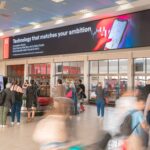Human beings are drawn to moving images. This is neatly illustrated by the exponential rise of video marketing over the past few years. With 87% of businesses now using video as a marketing tool, business-to-business (B2B) screens make more sense than ever before.
B2B screens are essentially screens used in any commercial space for a range of broad marketing purposes. For example, a bank branch might have screens in its waiting area showcasing market trends, investment advice and new products. Or, in a quick service restaurant environment, screens might highlight current promotions. In a train station, screens could display route information, schedules, and announcements.
Darren Francis, who manages B2B Information Displays for LG South Africa, says that while every type of business will require a different strategy to get the most value from B2B screens, there are a few general pointers to bear in mind.
“Lighting in retail is generally quite bright. Commercial Displays, thus, are much brighter than your standard domestic TV. This to attract more attention and not fade into the environment,” he says. “Viewing angles are also different. The viewing angle of a Commercial Display is 178 degrees, which is extremely wide in comparison to a domestic TV.”
Francis explains that whereas domestic TVs are generally switched on specifically for active viewing, commercial displays need to attract the attention of potential viewers by drawing their gaze. These screens therefore need to catch viewers’ eyes from multiple viewing points within the store.
Commercial displays are also designed to run for 24 hours a day without ever affecting the components. “This is critical to the longevity of the screens and overall brightness and functionality, maximising your investment,” Francis says. “Commercial displays can be installed and used in both landscape and portrait orientations. This gives marketing departments and agencies the flexibility to select different content resolutions for different outcomes. Interestingly, human psychology means that landscape-orientated content tends to be perceived as entertainment, while portrait-orientated content is considered for information or notices.”
Francis advises against using domestic screens in a commercial environment as they are not covered by warranty for retail or commercial use (basically, anywhere outside of the home environment).
Content for commercial environments is created differently to TV entertainment content. As audio is often not a factor, and people tend to be moving more than if they were watching a series on their couch, content should be short and flashy (to attract attention) and the messaging should be clear without audio.
Screen placement needs to be considered carefully and Francis suggests designing retail spaces with media and technology in mind, rather than as an afterthought. “It’s also important to find out about screen warranty and capabilities. For example, all LG commercial displays come with built-in media players, which means they don’t require an external player or computer,” he says. “Display options are endless – from single displays to video wall panels, transparent displays and flexible OLED panels. The most important thing is to design a solution that will work for your specific environment and customers.”
- Boomtown’s interns design new CI for Ubomi - 16th February 2022
- The Infinite Dial® 2022 South Africa to be presented on 24 February! - 16th February 2022
- It’s Random Acts of Kindness Week, and The Good Things Guy is named one of the world’s top 100 innovation success stories - 16th February 2022





